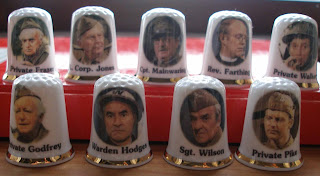Hi there,
These guys are the characters from Dad's Army, a British TV comedy from the 1970s. It was a sit-com about the Home Guard during the Second World War.
Originally called Local Defence Volunteers, the Home Guard was made up of men who were either too young or too old to enlist. Most were too old. Hence the nick-name Dad's Army. Their job was to defend the home front against possible invasion. In the early days, the Local Defence volunteers had to wait for equipment as the regular army had priority. This is where most of the more comic moments of the TV series came from. The never-ending enthusiasm to invent ways of hindering an invasion using whatever tools they had to hand. The re-runs are still popular today. An everlasting tribute to the real band of Dads and Grandads, all of them volunteers, who watched over and protected our coastline and homes.
Dad's Army is and always will be one of my all time favourite comedies. Which is why I read with some sadness today that Bill Pertwee, the actor who played Warden Hodges, has passed away.
So this is my tribute to the cast of Dad's Army the series:
These guys are the characters from Dad's Army, a British TV comedy from the 1970s. It was a sit-com about the Home Guard during the Second World War.
Originally called Local Defence Volunteers, the Home Guard was made up of men who were either too young or too old to enlist. Most were too old. Hence the nick-name Dad's Army. Their job was to defend the home front against possible invasion. In the early days, the Local Defence volunteers had to wait for equipment as the regular army had priority. This is where most of the more comic moments of the TV series came from. The never-ending enthusiasm to invent ways of hindering an invasion using whatever tools they had to hand. The re-runs are still popular today. An everlasting tribute to the real band of Dads and Grandads, all of them volunteers, who watched over and protected our coastline and homes.
Dad's Army is and always will be one of my all time favourite comedies. Which is why I read with some sadness today that Bill Pertwee, the actor who played Warden Hodges, has passed away.
So this is my tribute to the cast of Dad's Army the series:
 |
| Arthur Lowe 1915-1982 |
 |
| Clive Dunn 1920-2012 |
 |
| John Laurie 1897-1980 |
 |
| Arnold Ridley 1896-1984 |
 |
| Ian Lavendar 1946- |
 |
| James Beck 1929-1973 |
 |
| Frank Williams 1931- |
 |
| John Le Mesurier 1912-1983 |
 |
| Bill Pertwee 1926-2013
Bye for now
Olly
Facebook.com/olwenwhite/
instagram.com/olwenwhitewrites/
Twitter @OlwenWhite
|

Comments
Post a Comment